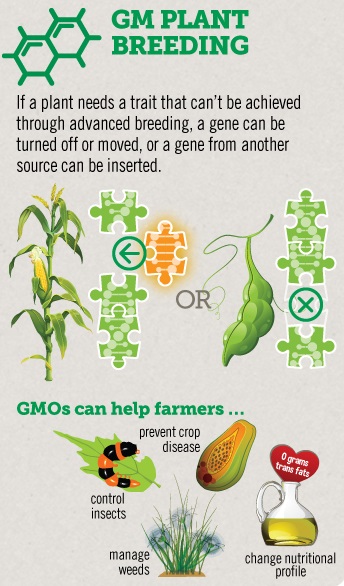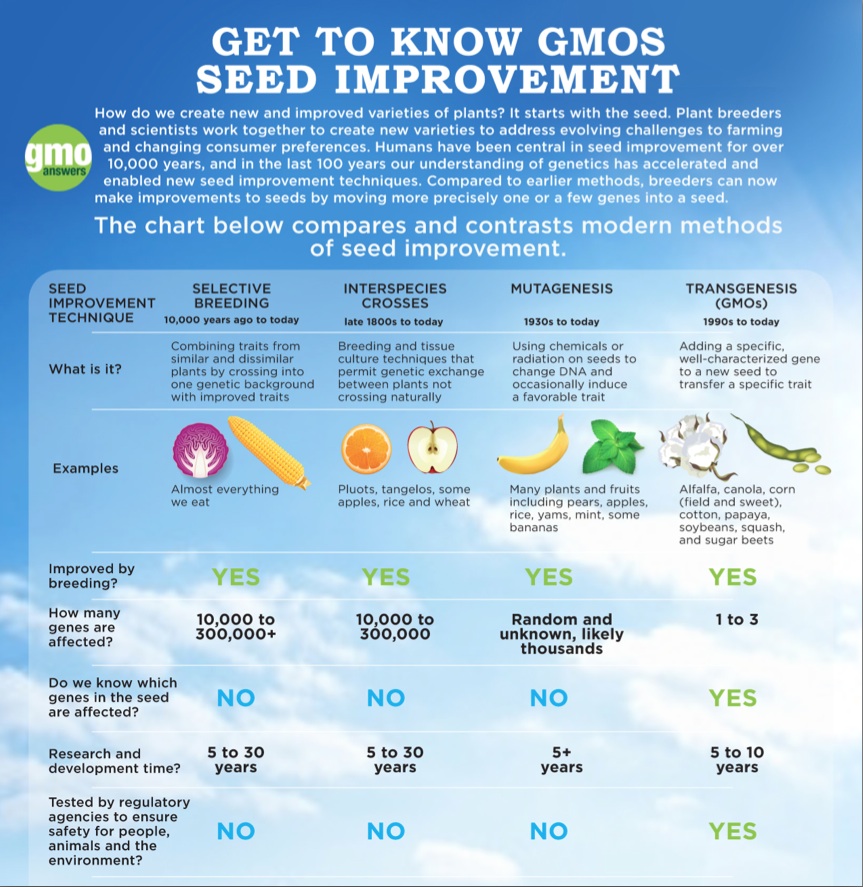Question
What are the benefits of GMOs and why are GMOs good?
Submitted by: Lilschneb
Answer
Expert response from Community Manager
Moderator for GMOAnswers.com
Monday, 25/04/2016 16:21
Why do people think GMOs are good? Well, to many, GMOs are considered an important tool in addressing complex issues around the globe. From environmental sustainability to nutritional benefits, we’ve outlined many reasons why GMOs are good and how they can provide benefits to farmers, consumers and the environment in the response below.
Benefits for farmers
There are many reasons to support GMOs but one of the most important is the benefit that genetically modified organisms can bring to farmers. So, why is genetically modified food good for farming? GMOs are created to achieve a specific, desired trait. For example, resistance to an insect or a specific herbicide or to enhance nutrition. Farmers choose seeds that are best for their farms and businesses. They determine which seeds, inputs and management practices are best for their land, business and growing conditions. Farmers choose seeds based on what is best for their farms, market demand and local growing environments. Farmers select GMOs to reduce yield loss or crop damage from weeds, diseases, and insects, as well as from extreme weather conditions, such as drought. Farmers choose to use GMOs to reduce the impact of agriculture on their environment and their costs — by applying pesticides in more targeted ways, for example. Farmers have also used GMOs to save a crop – such as papaya from Hawaii — that was being threatened by a disease. These are all reasons why GMOs are good for farmers.

What is good about GMOs?
So, why should we use GMOs and what are some examples of good GMOs? The ten GMO crops commercially available today were created for:
Disease resistance.
Through genetic modification, the Hawaiian papaya industry was able to recover from the devastating papaya ringspot virus that had crippled the industry.
Insect resistance.
This trait provides farmers with season-long protection against target pests, reduces the need for pesticide applications, and lowers input costs.
Drought resistance.
GM crops that express drought resistance can grow in much drier areas, conserving water and other environmental resources.
Herbicide tolerance.
Crops that can tolerate specific herbicides allow farmers to fight weeds by applying herbicides only when needed and enable them to use no-till production methods that preserve topsoil, prevent erosion, and reduce carbon emissions.
Enhanced nutritional profile.
High-oleic soybeans have been genetically modified to produce oil with more monounsaturated fat, less saturated fat and little to no trans-fat. Other GM crops are still being developed for nutritional improvement, including Golden Rice, which includes beta Carotene that could deliver vitamin A to children in developing nations.
Find out more about the benefits GMOs provide to farmers. Here, farmer Brian Scott also explains why he grows GMOs and The Genetic Literacy Project provides 10 reasons why GMOs are good.
Why GMO is good for our environment
GMOs in agriculture can increase biodiversity.
Another good thing about GMOs is that GM crops can increase productivity on existing agricultural land and protect biodiversity by sparing lands not intensively cultivated (Raven, 2010). The pressure on biodiversity will continue to decrease as global agricultural systems including GM crops expand to feed a growing world population (Carpenter, 2011) – a great example of why genetically modified food is good.
GMOs can increase productivity in agriculture.
Another reason why GMO is good is that it can increase productivity in agriculture. From 1996 to 2011, GM crops are estimated to have contributed to an additional global production of 195 million tons of maize, 110.2 million tons of soybeans, 15.85 million tons of cotton and 6.55 million tons of canola (Brookes and Barfoot, 2013). GM crops have contributed to higher yields, e.g., 30% more in some farming areas, and can contribute to poverty reduction and food security in developing countries (Qaim et al., 2010). How are GMOs good for CO2 emissions, then? Well, GMOs can reduce agriculturally-related greenhouse gas (GHG) emissions. Agricultural economist Graham Brookes reports: “GMOs have helped farmers reduce their environmental footprint by allowing them to use fewer inputs and enabling a shift to reduced tillage. These practices have led to less time spent on a tractor, less fuel used and fewer emissions. As a result...
GMOs have helped reduce CO2 emissions equivalent to removing 12.4 million cars from the road for one year. They have also led to 1.2 billion pounds less pesticides being used between 1996 and 2013.”
GMOs can reduce soil erosion.
Another reason GMOs are good is that herbicide tolerant (HT) crops enable more farmers to adopt conservation tillage because they help farmers to more effectively and efficiently control weeds at a lower cost than comparable conventional cropping systems. Florida farmer Lawson Mozley explains that with herbicide tolerant GM crops, weeds can be sprayed and left in the field to protect the soil. Then the incoming crop is planted directly into the leftover organic matter, without turning over the soil.
GMOs can help conserve water.
Why is GMO good for conserving water? Farmers utilize many tools to conserve water, including drip irrigation systems and conservation tillage practices. GMOs are good because they provide another tool that farmers can employ to help conserve water. Herbicide tolerant GM crops along with conservation tillage aid in soil moisture retention, which can reduce the need to irrigate. But, GMOs can help reduce water use in another way – drought tolerance. This GM trait can help crops cope with stress and yield more when periods of drought occur without supplemental water from irrigation.
GMOs can substantially decrease the use of many agricultural chemicals.
A common misconception is that the adoption of GM crops have increased the use of pesticides, when actually just the opposite is true. Overall GM crops, including crops with the “Bt” (Bacillus thuringiensis) traits for insect resistance, have contributed to a 37% decrease in pesticide applications. Not only is this beneficial to our environment, but another example of how GMOs are good for the farmers who grow them. Learn more about how some GMOs have led to the reduction in pesticide.
What does the future hold?
It’s nearly impossible to catalogue in one place all of the exciting research happening across the globe about why GMO foods are good and the many innovative products being developed by public institutions, private companies and public-private partnerships. In addition to the number of traits being developed to address weed resistance, destructive pests and diseases, drought-tolerance, saline-tolerance and nitrogen uptake, there are many examples of nutrient-enhanced staple crops under development in low and middle-income nations in Africa and Asia that demonstrate why GMOs are good. Examples include bananas, cowpeas, cassava, eggplant, and sweet potatoes.
Many people working in biotechnology are focused on uncovering good things about GMO food and the potential benefits of GMO technology and all that it can do to address complex challenges around the globe. Some of these ongoing an long-term goals include:
- Improving food availability and nutrition
- Helping farmers make better use of their land, water and labor resources
- Helping local farmers move beyond subsistence.
This photo gallery from the Daily Meal discusses if GMO Foods Can Save the World.
Additional resources
We have a variety of other resources available throughout the GMO Answers website and encourage you to explore more. Below are a few additional resources on this particular topic that you might find interesting.
Cecilia Chi-Ham, Director of Science & Technology at PIPRA and Kent Bradford, Director of Seed Biotechnology at UC Davis, also provide insight into how GMOs positively impact society in this response.
Our Pinterest page covers some of the good things about genetically modified food and other additional information.
- Farm Progress explains a study about GM crops and the return benefit for farmers.
- A report from PG Economics explains how GM crops allow farmers to grow more on less land.
- The infographic below explores why farmers are choosing to plant GM crops and the environmental benefits.
The infographic below explores the reasons why genetically modified foods are good for farming and why farmers are choosing to plant GM crops.

If you have additional questions, please let us know. Also, feel free to contribute to the discussion in the comment section below.
*as of 2018, there are 10 GMO crops commercially available in the U.S.